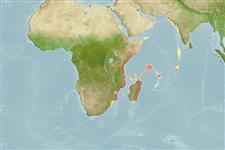>
Acanthuriformes (Surgeonfishes) >
Leiognathidae (Slimys, slipmouths, or ponyfishes) > Gazzinae
Etymology: squamiventralis: Named for the scalation of this species.
Environment: milieu / climate zone / depth range / distribution range
Ökologie
seewasser; tiefenbereich 4 - 13 m (Ref. 39894). Tropical
Verbreitung
Länder | FAO Gebiete | Ecosystems | Vorkommen | Point map | Einführungen | Faunafri
Western Indian Ocean: along the east coast of Africa from Kenya to Mozambique.
Size / Gewicht / Alter
Maturity: Lm ? range ? - ? cm
Max length : 9.6 cm SL Männchen/unbestimmt; (Ref. 39894)
Kurzbeschreibung
Bestimmungsschlüssel | Morphologie | Morphometrie
Rückenflossenstacheln (insgesamt) : 8; Rückenflossenweichstrahlen (insgesamt) : 16; Afterflossenstacheln: 3; Afterflossenweichstrahlen: 14; Wirbelzahl: 24. The ventrolateral surface of the body scaled anterior to a line from pectoral fin base to pelvic fin origin. Smooth supraorbital ridge (Ref. 39894).
Nothing is known on its ecology except specimens were collected from coastal waters shallower than about 13 m depth along with Gazza minuta (Ref. 39894).
Life cycle and mating behavior
Geschlechtsreife | Fortpflanzung | Ablaichen | Eier | Fecundity | Larven
Yamashita, T. and S. Kimura, 2001. A new species, Gazza squamiventralis, from the East coast of Africa (Perciformes: Leiognathidae). Ichthyol. Res. 48(2):161-166. (Ref. 39894)
IUCN Rote Liste Status (Ref. 130435: Version 2024-2)
Bedrohung für Menschen
Harmless
Nutzung durch Menschen
Tools
Zusatzinformationen
Download XML
Internet Quellen
Estimates based on models
Preferred temperature (Ref.
123201): 25.7 - 28.1, mean 27 °C (based on 114 cells).
Phylogenetic diversity index (Ref.
82804): PD
50 = 0.5312 [Uniqueness, from 0.5 = low to 2.0 = high].
Bayesian length-weight: a=0.01905 (0.00853 - 0.04255), b=2.95 (2.76 - 3.14), in cm total length, based on LWR estimates for this (Sub)family-body shape (Ref.
93245).
Trophic level (Ref.
69278): 3.0 ±0.4 se; based on size and trophs of closest relatives
Widerstandsfähigkeit (Ref.
120179): hoch, Verdopplung der Population dauert weniger als 15 Monate. (Preliminary K or Fecundity.).
Fishing Vulnerability (Ref.
59153): Low vulnerability (10 of 100).
